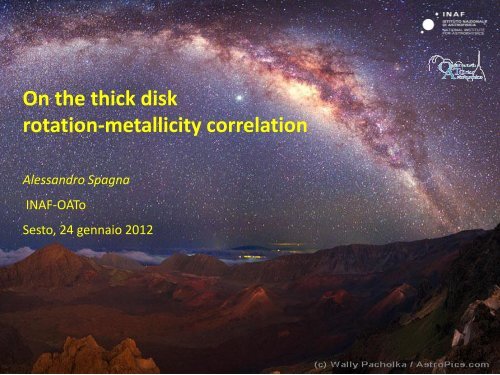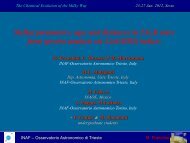On the thick disk rotation-metallicity correlation
On the thick disk rotation-metallicity correlation
On the thick disk rotation-metallicity correlation
You also want an ePaper? Increase the reach of your titles
YUMPU automatically turns print PDFs into web optimized ePapers that Google loves.
<strong>On</strong> <strong>the</strong> <strong>thick</strong> <strong>disk</strong><br />
<strong>rotation</strong>-<strong>metallicity</strong> <strong>correlation</strong><br />
Alessandro Spagna<br />
INAF-OATo<br />
Sesto, 24 gennaio 2012
Collaborators<br />
Anna Curir<br />
Mario G. Lattanzi<br />
Francesca Matteucci<br />
Giuseppe Murante<br />
Paola Re Fiorentin<br />
Richard L. Smart<br />
Emanuele Spitoni<br />
Alvaro Villalobos<br />
Expertise<br />
Astrometry<br />
Spectro-photometry<br />
Galactic dynamics<br />
Chemical models
Outline<br />
• Introduction<br />
• Problem: <strong>thick</strong> <strong>disk</strong> formation<br />
• Observed <strong>rotation</strong>-<strong>metallicity</strong> <strong>correlation</strong><br />
• Results from N-body simulations<br />
• Conclusions
Introduction<br />
Local cosmology: we look for archeological relics<br />
of <strong>the</strong> chemo-dynamical evolution of <strong>the</strong> Milky Way
Age-<strong>metallicity</strong> relation<br />
As indication of <strong>the</strong> radial mixing in <strong>the</strong> galactic <strong>disk</strong><br />
dispersion<br />
mean<br />
3300 stars within 75 pc from <strong>the</strong> Sun<br />
(Haywood 2008, MNRAS, 388, 1175)
The origin of <strong>the</strong> Thick <strong>disk</strong>?
The origin of <strong>the</strong> Thick <strong>disk</strong>?<br />
Heating of a galactic<br />
<strong>disk</strong> by a merger of a<br />
high density small<br />
satellite.<br />
N-body simulations by<br />
Quinn et al.<br />
(1993, ApJ, 403, 74)
The origin of <strong>the</strong> Thick <strong>disk</strong>?<br />
1. kinematical heating of a pre-existing old <strong>disk</strong> via minor<br />
mergers (Quinn et al. 1993, Villalobos & Helmi 2008)<br />
2. stars formed in situ (Jones & Wise 1983, Chiappini 2009)<br />
3. Chaotic mergers of gas-rich systems and intense star<br />
formation (Brook et al. 2005)<br />
4. stellar accretion of merged satellites (Abadi et al. 2003)<br />
5. kinematical heating from massive star clusters (Kroupa<br />
2001)<br />
6. radial migration due to secular dynamical processes<br />
(Schonrich & Binney 2009)
Radial migration in spirals<br />
• Stars in <strong>disk</strong>s of spiral galaxies were usually assumed<br />
to remain roughly at <strong>the</strong>ir birth radii.<br />
• Indeed stars migrate across significant galactocentric<br />
distances due to resonant scattering with transient<br />
spiral arms, while preserving <strong>the</strong>ir circular orbits<br />
Wielen, R. 1977, A&A, 60, 263<br />
Sellwood, J. A., & Binney, J. J. 2002, MNRAS, 336, 785<br />
Schonrich, R. & Binney J. 2009, MNRAS, 396, 203
A&A 510, L4 (2010)<br />
20,000 FGK<br />
(sub)dwarfs from<br />
SDSS-GSC-2 catalog,<br />
1.0 kpc 0.55 mag<br />
(Klement et al<br />
2009) to remove<br />
turn-off stars
A&A 510, L4 (2010)<br />
40-50 km/s/dex
Kinematic deconvolution of<br />
halo and <strong>disk</strong> stars<br />
6538 stars from SDSS-GSC-2 catalog,<br />
1.5 kpc < |z| < 3 kpc and [Fe/H]
Thick <strong>disk</strong> kinematic-<strong>metallicity</strong> <strong>correlation</strong><br />
Spagna et al (2010)
No evidence of <strong>correlation</strong> in <strong>the</strong> SDSS<br />
photometric sample ?!<br />
Ivezic et al (2009),<br />
Bond et al (2010, ApJ, 716, 1)
New observational results<br />
on <strong>the</strong> relation Vφ vs. [Fe/H]<br />
• Lee et al (2011) confirm <strong>the</strong><br />
<strong>correlation</strong> discovered by<br />
Spagna et al using similar SDSS<br />
data<br />
• Kordopatis et al. (2011) confirm<br />
<strong>the</strong> <strong>correlation</strong> using<br />
independent spectroscopic<br />
VLT/FLAMES data
«Old» observational results<br />
on <strong>the</strong> relation Vφ vs. [Fe/H]<br />
Rotation-<strong>metallicity</strong> <strong>correlation</strong><br />
found in 150 subdwarfs in <strong>the</strong> solar<br />
neighbourhood with accurate<br />
kinematics from Hipparcos catalog<br />
(Gratton et al, 2003 A&A, 406,<br />
131)
«Old» observational results<br />
on <strong>the</strong> relation Vφ vs. [Fe/H]<br />
Rotation-<strong>metallicity</strong> <strong>correlation</strong><br />
found in 150 subdwarfs in <strong>the</strong> solar<br />
neighbourhood with accurate<br />
kinematics from Hipparcos catalog<br />
(Gratton et al, 2003 A&A, 406,<br />
131)
Results from N-body simulations<br />
• We performed high resolution N-body<br />
simulations (20 million particles) designed to<br />
study <strong>the</strong> dynamical evolution of a stellar<br />
<strong>disk</strong> inside a Dark Matter halo.<br />
• Our <strong>disk</strong> models are conceived in a non<br />
dissipative framework: we want to evaluate<br />
<strong>the</strong> effect of pure dynamics on <strong>the</strong> radial<br />
migration.
Disentangling chemistry from dynamics<br />
• We assume an old stellar population (no star<br />
formation, no stellar evolution)<br />
• Each particle in <strong>the</strong> initial configuration is<br />
tagged with a [Fe/H] label, according to <strong>the</strong><br />
initial chemical radial distribution of Spitoni &<br />
Matteucci (2011) based on Chiappini et al.<br />
(2007)<br />
• we wish to follow <strong>the</strong> redistribution of <strong>the</strong><br />
<strong>metallicity</strong> inside <strong>the</strong> <strong>disk</strong> due to radial mixing.
Where do stars come from?<br />
T = 5 Gyr<br />
8 kpc < R
Comparison with SDSS-GSC II Catalog data<br />
Velocity distribution<br />
model<br />
data<br />
Simulated distribution of azimuthal<br />
Velocity vs. radial velocity from <strong>the</strong> barred<br />
Disk model:<br />
8kpc
Evolution of <strong>the</strong> chemical gradients:<br />
velocity-chemistry <strong>correlation</strong><br />
1<br />
2<br />
We follow <strong>the</strong> chemical<br />
redistribution of an initial<br />
assigned <strong>metallicity</strong><br />
gradient:<br />
panel 1 shows <strong>the</strong> initial<br />
gradient over all <strong>the</strong> <strong>disk</strong><br />
taken from Chen et al<br />
(2009).<br />
In panel 2 we show as <strong>the</strong><br />
dynamical evolution of such<br />
gradient produces (in <strong>the</strong><br />
solar annulus (8-10 kpc))
Evolution of <strong>the</strong> chemical gradients:<br />
velocity-chemistry <strong>correlation</strong><br />
1<br />
2<br />
We follow <strong>the</strong> chemical<br />
redistribution of an initial<br />
assigned <strong>metallicity</strong><br />
gradient:<br />
panel 1 shows <strong>the</strong> initial<br />
gradient over all <strong>the</strong> <strong>disk</strong><br />
taken from Chen et al<br />
(2009).<br />
In panel 2 we show as <strong>the</strong><br />
dynamical evolution of such<br />
gradient produces (in <strong>the</strong><br />
solar annulus (8-10 kpc))a<br />
velocity-<strong>metallicity</strong><br />
<strong>correlation</strong> similar to <strong>the</strong><br />
ones shown in Shonrich and<br />
Binney (2009) (panels 3 and<br />
4)<br />
3<br />
GCS data<br />
Standard model by<br />
Shonrich and Binney (2009)<br />
4
Evolution of <strong>the</strong> chemical gradients:<br />
velocity-chemistry <strong>correlation</strong><br />
1<br />
2<br />
We follow <strong>the</strong> chemical<br />
redistribution of an initial<br />
assigned <strong>metallicity</strong><br />
gradient:<br />
panel 1 shows <strong>the</strong> initial<br />
gradient over all <strong>the</strong> <strong>disk</strong><br />
taken from Chen et al<br />
(2009).<br />
In panel 2 we show as <strong>the</strong><br />
dynamical evolution of such<br />
gradient produces (in <strong>the</strong><br />
solar annulus (8-10 kpc))a<br />
velocity-<strong>metallicity</strong><br />
<strong>correlation</strong> similar to <strong>the</strong><br />
ones shown in Shonrich and<br />
Binney (2009) (panels 3 and<br />
4)<br />
3<br />
GCS data<br />
Standard model by<br />
Shonrich and Binney (2009)<br />
4
Two infall model:<br />
inside-out <strong>disk</strong> formation<br />
(Matteucci et al )
«Inverse» chemical radial distribution<br />
Stellar population expected at T = 2 Gyr after star formation<br />
Spitoni & Matteucci (2011) based on Chiappini et al (2007)
Barred <strong>disk</strong> simulation (t=5 Gyr)<br />
100 km/s/dex<br />
1.5 kpc < |z| < 2.0 kpc<br />
Curir, Spagna, Lattanzi, Matteucci,<br />
Murante, Re Fiorentin & Villalobos<br />
(2012, submitted)<br />
SDSS – GSC-II catalog<br />
40-50 km/s/dex<br />
1.5 kpc < |z| < 3.0 kpc
Inverse chemical gradients<br />
observed at high redshift<br />
• Negative radial <strong>metallicity</strong> gradient in local<br />
spiral galaxies: <strong>the</strong> central <strong>disk</strong> region is more<br />
metal-enriched than <strong>the</strong> outer regions.<br />
• More complex situation in larger samples:<br />
even positive “inverted” gradients at z~1.5 in<br />
MASSIV (Mass Assembly Survey) galaxies<br />
Thanks to <strong>the</strong> AMAZE/LSD data: First <strong>metallicity</strong><br />
maps at z ~3:<br />
• Three undisturbed <strong>disk</strong>s<br />
• • Well defined regions close to <strong>the</strong> SF peak are<br />
less metal enriched than <strong>the</strong> <strong>disk</strong>.<br />
• (Cresci, Maiolino, Mannucci et al 2011)
Conclusions<br />
• We have detected a <strong>rotation</strong>/<strong>metallicity</strong> <strong>correlation</strong> in <strong>the</strong><br />
<strong>thick</strong> <strong>disk</strong> population that represents an important<br />
signature of <strong>the</strong> formation processes of <strong>the</strong> galactic <strong>disk</strong>s<br />
• For <strong>the</strong> first time, high resolution N-Body models can<br />
account for a similar <strong>correlation</strong>, Vphi-[Fe/H], produced by<br />
<strong>the</strong> stellar radial migration, if we assume an initial<br />
«inverse» chemical gradient in <strong>the</strong> inner <strong>disk</strong><br />
• This scenario, based on local observations, appears<br />
consistent with <strong>the</strong> properties of isolated <strong>disk</strong> galaxies at<br />
high redshift





